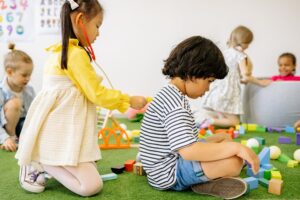World Children’s Day: An Opportunity to Discuss Rights and Responsibilities with Children
Every year on 20 November, World Children’s Day is celebrated. It was originally established in 1954 as an opportunity to raise awareness of children’s welfare. It explored their individual situations around the globe, with the aim of improving them. This specific date is chosen as the UN General Assembly adopted the Declaration of the Rights of the Child on that day in 1959, as well as being when that same Assembly in 1989 ratified the UN Convention on the Rights of the Child.
These rights are important for raising the standards of children’s care and welfare. World Children’s Day is a great conversation starter for children and adults to enable them to advocate and promote both human and children’s rights to build a better world.
 This year’s theme is A Better Future for Every Child which concentrates on the world as it recovers from the pandemic. For this generation of children and young people, the issues that are important for them to speak out on include, climate change, access to quality education, vaccine equity and mental health. The United Nations states that in this new climate, “it’s more important than ever that we listen to them (children)” as they call for adults to help create a better future.
This year’s theme is A Better Future for Every Child which concentrates on the world as it recovers from the pandemic. For this generation of children and young people, the issues that are important for them to speak out on include, climate change, access to quality education, vaccine equity and mental health. The United Nations states that in this new climate, “it’s more important than ever that we listen to them (children)” as they call for adults to help create a better future.
How do we do this in the classroom?
Educators and teachers have a great influence in being an advocate for children’s rights. It is a part of ensuring that the young people they teach develop into well-rounded individuals, capable of standing up for what they believe in.
This is very much aligned with KneoWorld’s pedagogy that supports education as a process of growth and reflection. When we understand what is important to children and young people, we can provide for them and support them in their own personal growth and the responsibility that comes with rights.
Justin D Bibee (2015) discusses various ways educators and teachers can support learning about human rights.
“Methodologies used to teach about human rights include three elements: learning about human rights, learning for human rights, and learning through human rights. In other words, students should be aware of the issues, concerned by the issues, and capable of standing up for issues.”
 By offering age-appropriate lessons, educators can embed the teaching of human rights into the existing curriculum. For example, promoting Article 12 of the UN Convention on the Rights of the Child, which relates to children’s opinions being considered in matters that affect them, can be done via persuasive writing or through student representatives. Article 8 discusses the right to an identity, which can be used as a stimulus for geography or history-based activities.
By offering age-appropriate lessons, educators can embed the teaching of human rights into the existing curriculum. For example, promoting Article 12 of the UN Convention on the Rights of the Child, which relates to children’s opinions being considered in matters that affect them, can be done via persuasive writing or through student representatives. Article 8 discusses the right to an identity, which can be used as a stimulus for geography or history-based activities.
Additionally, since discussions about human rights can be sensitive, it is important to invite children to participate only when trust has been formed. Ground rules should be established amongst the class to ensure that the space is a safe place to talk, and views are respected. This is a great lesson in understanding the responsibility that is associated with a given right.
When planning activities, it is important to consider the following outcomes as a guideline to measure their success ensuring children have a greater understanding of human rights.
- Students can recognize a violation of human rights.
- Learners have the necessary skills to defend human rights.
- Children are respectful and place the rights of others in high regard. This includes being able to listen and attempt to understand viewpoints that differ to their own.
- Appreciate that everyone, from birth, is entitled to the same human rights as per the Universal Declaration of Human Rights.
- Understand and appreciate the key concepts of freedom, justice, equality, human dignity, democracy, sustainability, poverty, universality, rights, responsibilities, interdependence, conflict resolution, and globalization.
- Learners understand that human rights provide a basis for standards of behavior at home, at school, and in the wider community.
- Students can use respectful language, irrespective of race, gender, religion, sexual orientation, class, and size.
These can be demonstrated via the following values (Bibee, page 14)
- A commitment to learning.
- A belief that people can make a difference.
- A commitment to democratic processes.
- Curiosity, an open mind, and an appreciation of diversity,
- Empathy and solidarity with others and a commitment to support those whose human rights are under threat.
- A sense of justice and the desire to work toward the ideals of freedom, equality, and respect for diversity.
What areas should we be focusing on?
 Many of the teaching methodologies will be based upon storytelling and discussions as well real-world scenarios. It needs to be relatable for students to understand what it means to them personally.
Many of the teaching methodologies will be based upon storytelling and discussions as well real-world scenarios. It needs to be relatable for students to understand what it means to them personally.
- Distinguishing between rights, wants, and needs.
- Understanding children’s rights as per the UN Convention on the Rights of the Child.
- What it means to be a global citizen, including within the realm of war, peace, and human rights.
- Respect for themselves and each other, asking them about when they felt truly respected and listened to and what made them feel that way.
- Appreciating similarities and differences, ensuring they are not discriminative. This includes freedom of thought, conscience, religion, opinion, and expression.
- Understanding their and others’ right to privacy, particularly within the realm of social media.
KneoWorld strives to achieve equity in education, which is fundamental to children’s rights. Human rights are also considered to be a part of social and emotional learning, which KneoWorld supports through its story-based learning platform. Learning Stories, Task-Based Games, Adventure Stories, Brain Games, and Hands-On Activities and Challenges, form the core components and are provided to help students understand society’s expectations of them, which, in turn, empowers their creativity and drive to learn.
Learn more about how KneoWorld can support your teaching here.


